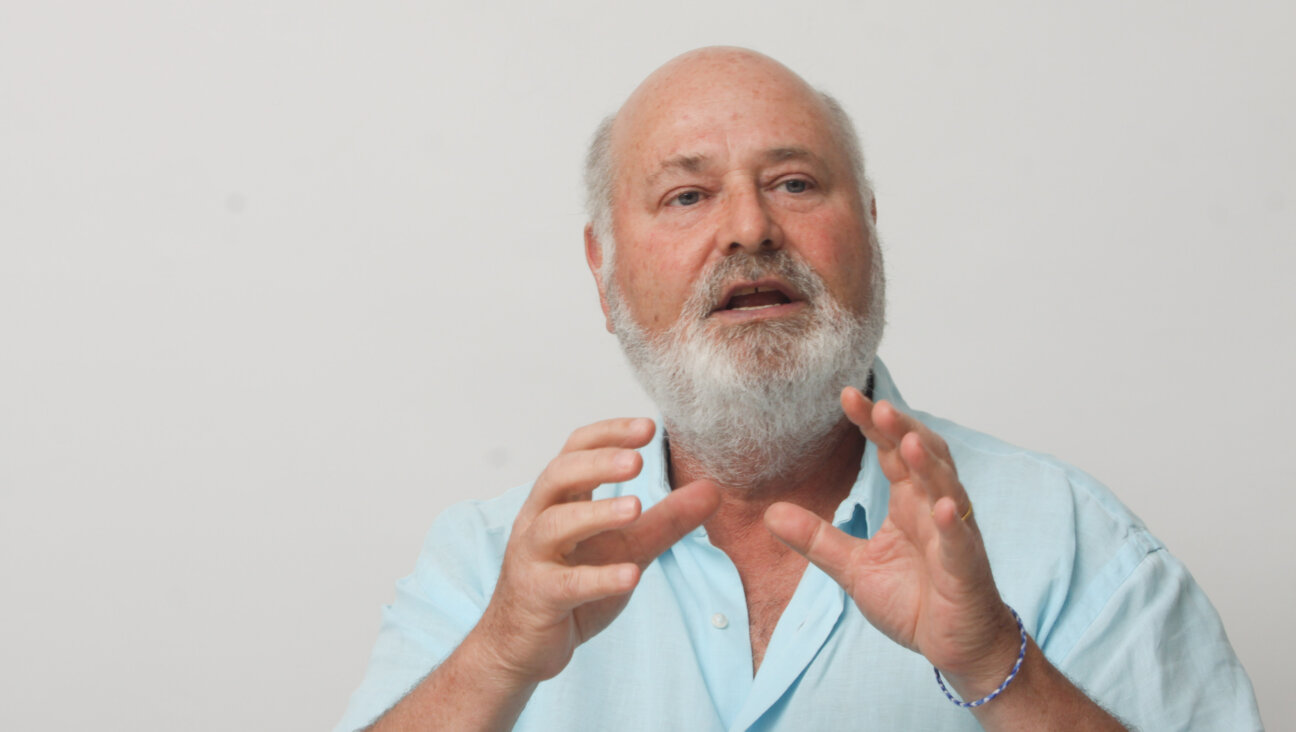How Yiddish slogans captured a controversial cover story — and the precarious state of American Jews
The Atlantic’s new issue features a deep dive into American antisemitism. Its cover tells a slightly different story

“No one’s ever done it before,” said Atlantic editor-in-chief Jeffrey Goldberg of the Yiddish text on the magazine’s new cover, and “there’s a reasonable chance that no one will ever do it again.” Courtesy of The Atlantic
Is it “a hop, skip and a jump” from Charles Lindbergh to Kanye West?
According to the somewhat tongue-in-cheek Yiddish slogans plastered across the cover of the April issue of The Atlantic, yes.
The cover, built around Franklin Foer’s story “The Golden Age of American Jews is Ending,” takes the form of a poster from the century-past heyday of American Yiddish theater: Photographs of eminent American Jews framed by a series of English and Yiddish quips advertising the subject matter inside. It’s the most prominent billing the storied publication — per Foer, one of the country’s “WASPiest magazines” — has ever given the Ashkenazi language. (Disclosure: I occasionally write for The Atlantic.)
In invoking the legacy of New York’s Yiddish theater, the cover was designed to acknowledge a truth that resides at the heart of Jewish culture: Almost no circumstances are ever too concerning to make the application of a little humor inappropriate.
“I like a good inside joke,” said Atlantic editor-in-chief Jeffrey Goldberg, “and I thought instead of just having some symbolic Yiddish on the cover to make it look authentic, I wanted to have a little fun with it.”
So: Under the cover’s English-language announcement of “Jews Fleeing Schools,” the Yiddish question: “Has a dybbuk overtaken the Ivy League universities?”
That particular inquiry taught David Roskies, the Jewish Theological Seminary professor who composed the Yiddish text for the cover, something new — namely, that there’s an accepted Yiddish translation for “Ivy League.”
Unsurprisingly, there isn’t one for perhaps the most famous American antisemite of the 21st century. “So I had to figure out, how do you say ‘Kanye West’?” Roskies said.
Foer’s story situates the new landscape of American antisemitism, following the Oct. 7 Hamas attacks and Israel’s war in Gaza — which has so far killed more than 30,000 Palestinians — within “the stream of American political history,” Goldberg said. It places a particular emphasis on “a deep historical understanding of the roles that Jews have played in the development of mainstream liberalism.” (Asked whether he was concerned that some might perceive the story’s prominent placement as tone deaf given the dire facts of the war, Foer said, “I don’t see why it’s necessarily inconsistent to be able to worry about what’s happening in the Middle East and to worry about the way in which the protests here are doing damage to American life.”)
The callback to the Yiddish theater, which helped define a new immigrant Jewish culture for several decades at the end of the 19th century and start of the 20th, adds a bittersweet undertone to that framing.
“The Yiddish theater was a vehicle for Americanization,” Roskies said. “It was a way of working through the trauma of mass immigration.” Actors performed original Yiddish scripts alongside translations of William Shakespeare, Henrik Ibsen and George Bernard Shaw. For a newly-arrived immigrant, Roskies said, seeing actors “performing in your own language” helped form connections between specifically Jewish concerns and universal ones.
“Your culture is autonomous,” was the message to audiences, Roskies said. “It speaks to the world, and you are the world.”
In some ways, the Yiddish theater epitomized a unique quality of American Jewish culture: It was built for a narrowly defined audience, and ended up broadly influencing the development of American culture at large. Theatrical innovators like Lee Strasberg, who through his Actors Studio trained performers like Marilyn Monroe, Paul Newman and Al Pacino, got their start in the downtown Yiddish scene.
That scene found a new flourishing in the interwar years. So, at least temporarily, did the American Jewish community at large, embarking on a pre-Depression period of cultural and economic ascendance. But after the U.S. largely stopped admitting new immigrants with a set of draconian quota laws passed in 1924, the Yiddish theaters could only sustain themselves for so long. “If you buy this theory that we’re exiting the Golden Age,” Goldberg said, “it was about a hundred-year act.”
A concern with the shifting status of 21st-century Jews isn’t new for The Atlantic. Almost exactly nine years ago, Goldberg wrote the magazine’s April, 2015 cover story, “Is it Time for the Jews to Leave Europe?” Certain segments of that article seem like they could be pulled from news appearing today — not least an extended quote by President Joe Biden, who was still vice president to President Barack Obama at the time of Goldberg’s reporting.
“You understand in your bones that no matter how hospitable, no matter how consequential, no matter how engaged, no matter how deeply involved you are in the United States … there’s only one guarantee,” Biden, as related in Goldberg’s article, told an audience at a Rosh Hashanah gathering. “There is really only one absolute guarantee, and that’s the state of Israel.”
That rhetoric, Goldberg said, “suggests a very bleak view of life in America.”
That 2015 issue’s cover made a purely sober statement: It showed cracks spreading across a concrete Star of David, in dramatic grayscale. (Much of that story is set in France. Incidentally, one of the only other instances in which The Atlantic incorporated a foreign language on its cover was for a 1972 issue, which included fiction by Bernard Malamud, that featured the French headline “Liberté! égalité! Chasteté!”)
The wry comedy built into the cover art for Foer’s counterpart to Goldberg’s dispatch makes a different kind of point: that the mental landscape Jews occupy now is a bit baffling, a bit ridiculous.
“So often, I hear American Jews say Israel has put them in a terrible position, and maybe they should make aliyah to Israel,” Foer said. “Those two impulses of panicking about the consequences of the war and then reaching to Israel as a potential safety valve exist simultaneously.”
“I was gonna call this story ‘Is it Time for the Jews to leave Oakland,'” Goldberg said, before clarifying: “That’s a joke.”
Hence, the too-sassy-for-its-own-seriousness query in the cover’s bottom right corner: “Me darf aykh araynleygn a finger in moyl?” — “Do I need to spell it out for you?”
“Irony is the ability to hold two conflicting opinions at the same time,” said Roskies. “And that’s what Yiddish does automatically. It’s built into the language.”
And it’s also built, perhaps, into the process of reporting a story about the jeopardy faced by American Jews as a Jew prominently employed at a magazine co-founded by Ralph Waldo Emerson. “To see Yiddish on the cover of The Atlantic makes me question that it’s the end of the golden age,” Foer said.
















